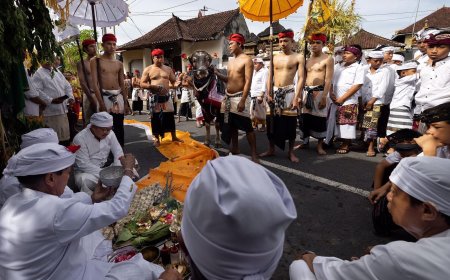Ancient Tradition of Les Village: The Prohibition of Using Bajra for Pemangku
Les Village, as one of the Bali Mula or Bali Aga villages, has unique characteristics in its religious traditions. While bells are usually important in Hindu ceremonies, in Les Village, the bells are of a niskala (invisible and inaudible) nature, accompanied by local mantras that use Bali or Kawi language. The village Pemangku also uses a penyungsung containing pis bolong, offerings, and incense while leading the ceremonies. The prohibition against using bells has been passed down through generations to this day.
The Balinese people are deeply rooted in their traditions of Tatanan pranata and belief systems. The terms Bali Aga and Bali Mula are often used to distinguish between Wong Majapahit and Bali Aga. There are several characteristics, one of which is the language or dialect in terms of pronunciation. Recently, the term Bali Mula community has emerged, which is said to be different from Bali Aga. It is believed that Bali Aga originated from Java (specifically from desa Aga) that came to Bali before the Majapahit invasion and conquest of Bali. In contrast, the Bali Mula community consists of those who were indeed created in Bali before any life existed there (see Babad Kayu Selem). The Bali Mula community is also known as Catur Sanak, which includes Kayu Selem, Kayuan, Celagi, and Tarumenyan (Trunyan). The center of the Bali Mula settlement area is around Kintamani, with its largest temple being Pura Pucak Panarajon or Pucak Penulisan. Other temples include Pura Dalem Balingkang, Pura Baleagung Sukawana, and Pura Puseh Panjingan in Les Village.
Every village in Bali has its own history regarding its founding. Les Village is located at the eastern tip of Buleleng Regency and has a story behind the name of the village itself. The narrative of the establishment of Les Village has not yet been found in written records; however, it is told based on oral traditions passed down from ancestors. This means the story of the founding of Les Village has been transmitted orally. The consequence of this oral tradition is the emergence of multiple versions of the story, which relates to the varying sharpness of memory among those who receive the narrative.
Based on one version recounted by the late I Ketut Wirsa, there was a customary ceremony in Panjingan Village where a group of Wong Bajo, known as "people of the boats," came and were interested in joining a cockfighting event. They saw a siginangsi rooster, a white-feathered chicken with one black feather, which was famous for always winning fights. Intrigued, the Wong Bajo asked the local cockfighters of Panjingan Village to find a siginangsi rooster for them to buy and enter into the fight.
However, one of the local cockfighters cheated by providing a regular white chicken with one of its feathers dyed black, making it appear to be a siginangsi. The Wong Bajo purchased it for a high price, believing it would win. However, when the fight occurred, the rooster lost, and the Wong Bajo realized they had been deceived. Filled with anger, they left, vowing to return. After the Wong Bajo's threatening farewell, fear gripped Panjingan Village. The local cockfighters continued to worry about possible revenge from the Bajo sailors, known to be strong and fearless. Day by day, their fear grew, especially upon hearing news of a fleet of sailing boats passing through the surrounding waters.
Eventually, when several Wong Bajo boats were seen approaching from the west, the villagers of Panjingan felt that the day of retribution had come. They feared that the Wong Bajo had returned to avenge their defeat in the cockfight and the deception that had taken place. As the boats drew closer, the tension in the village escalated. However, it turned out that the boats were merely passing through on their way to Lombok and Sumbawa for trading. The fear that had enveloped Panjingan Village gradually faded, but the incident remained a reminder of the importance of maintaining good relationships with outsiders and the negative consequences of deceit.
After the procession of Wong Bajo boats was sighted from a distance, a villager from Panjingan rushed to report this, causing panic in the village. The villagers assumed the Wong Bajo would attack to take revenge for being cheated in the cockfighting event. The fear spread, and the villagers agreed to leave the village to avoid danger. They split into two groups: one headed towards Bukit Buhu, and the other went into the forest.
The group that ran to Bukit Buhu established an emergency refuge under a large tree. They brought with them eight sanggah kemulan, which are important spiritual symbols. However, since Bukit Buhu was still visible from the sea, they decided to move to a safer location, namely Bukit Yangudi, which was higher and protected by a ravine. In Bukit Yangudi, they felt safe because they could see any attacks from the Wong Bajo, although the conditions there were not suitable for permanent settlement due to a lack of water and agricultural land.
Boboran Mampeh Waterfall (Source: Editorial Collection)

































































